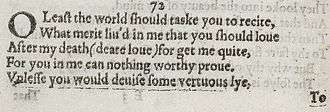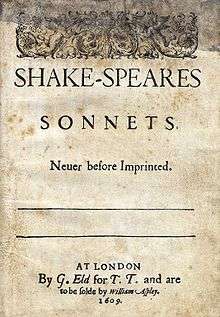Sonnet 72
| Sonnet 72 | |||||||
|---|---|---|---|---|---|---|---|
 The first five lines of Sonnet 72 in the 1609 Quarto | |||||||
|
| |||||||
| |||||||
Sonnet 72 is one of 154 sonnets written by the English playwright and poet William Shakespeare. It is a member of the Fair Youth Sequence, in which The Poet expresses his love toward a young man. The Fair Youth Sequence includes Sonnet 1 through Sonnet 126. Sonnet 72 prominently features a dark, morbid tone with references to death and the afterlife.
Synopsis
Sonnet 72 is an extension of Sonnet 71. In it The Poet wrestles with feelings of inadequacy and mortality, specifically how his works will live on after his own death. The Poet addresses a young male lover. Throughout, The Poet urges him to forget their love and his works upon The Poet's death.
Structure
Sonnet 72 is an English or Shakespearean sonnet. The English sonnet has three quatrains, followed by a final rhyming couplet. It follows the typical rhyme scheme of the form, abab cdcd efef gg and is composed in iambic pentameter, a type of poetic metre based on five pairs of metrically weak/strong syllabic positions. The fifth line (accepting a 2-syllable pronunciation of "virtuous"[2]) exemplifies a regular iambic pentameter:
× / × / × / × / × / Unless you would devise some virtuous lie, (72.5)
- / = ictus, a metrically strong syllabic position. × = nonictus.
In line nine, the lexical stress of "true" would normally be subordinated to that of "love", fitting most naturally into × / which here would create an unmetrical line. Placing contrastive accent upon "true" saves the meter...
× / × / × / × / × / O! lest your true love may seem false in this (72.9)
... and, it is revealed later in the line, is appropriate to the sense, as "true love" is contrasted with seeming "false" — an example of Shakespeare using metrical expectations to highlight shades of meaning. ("O! lest" may alternatively be scanned / ×, an example of an initial reversal, as also occurs in line three, and optionally in lines one and thirteen.)
Sonnet 72 is not without its opponents debating the inconsistencies of textual layout and problematic structure. There are many inconsistencies; grammar, capitalization, and punctuation that could easily change the tone and structure of the sonnet. In the 1640 text of Sonnet 72, the L is capitalized in the first line of the Quarto, to read O Least the world. The second letter of each first line is subsequently capitalized, casting doubt on the Sonnet's tone. It's possible this may be due to an error of the printer, but nonetheless it slightly changes the original intent of the Sonnet.[3]
Context
_cropped.png)
Sonnet 71 through Sonnet 74 are often grouped together as a linear sequence due to their dark, brooding tone, and The Poet's obsession with his own mortality and legacy.[4] The sequence begins in Sonnet 71 with "No longer mourn for me when I am dead" and ends with "And that is this, and this with thee remains" in Sonnet 74.[5] Sonnet 72 is one of 126 Sonnets coined "The Fair Youth Sequence". The identity of said "Fair Youth" remains a mystery. Several scholars point, in particular to Henry Wriothesley, 3rd Earl of Southampton and William Herbert, 3rd Earl of Pembroke.[5]
Analysis
Sonnet 72 is a continuation from Sonnet 71. Both sonnets are an anticipatory plea regarding death and the afterlife from the writer to the reader.[5] The overarching subject of Sonnet 72 is The Poet's fixation with how he will be remembered after death. Subsequently the tone remains bleak and self-depreciating.[5]
Theme
John Cumming Walters states: "In the sonnets we may read the poet's intents, hopes, and fears regarding his fate, and we learn of his all consuming desire for immortality...Bodily death he does not fear: oblivion he dreads."[6]
In Line 2 The Poet discusses his own mortality and worth by asking, "What merit lived in me that you should love". Keeping with his theme of death, The Poet employs the use of morbid imagery in Line 7: "And hang more praise upon deceased I". A reference to the practice of the time of hanging Epitaphs/Trophies on the gravestone or marker of the deceased.[5] Line 10 states "that you for love speak well of me untrue". Here The Poet is stating if his young lover were to speak well of him after death, he would be lying. The last couplet of the sonnet alludes that a dead poet is worthless, or has no value. "For I am shamed by that which I bring forth/And so should you, to love things nothing worth."
Exegesis
The text of Shakespeare's sonnets has been open to debate for quite some time. In 1640, a volume of poems was issued by John Benson of St. Dunstan's Chuchyard, which contained several pieces that had been collected in 1609. The collection is often thought of as the second edition of Sonnets, and may not be the version that Shakespeare publicly acknowledged or intended for the public to see.[3]
Line 13 of the couplet states: "For I am shamed by that which I bring forth." This refers to the Biblical verses in Mark: 7.20-23 "That which cometh...and defile the man." Line 14 of the couplet states: "And so should you, to love things nothing worth." This alludes to the Biblical verse in Job 24.25 "Who will make me a liar, and make my speech nothing worth?" Here, The Poet is utilizing Biblical texts to reaffirm the baseless nature of both himself and his poetry.[5]
References
- ↑ Pooler, C[harles] Knox, ed. (1918). The Works of Shakespeare: Sonnets. The Arden Shakespeare [1st series]. London: Methuen & Company. OCLC 4770201.
- ↑ Booth 2000, p. 258.
- 1 2 Alden, Raymond MacDonald. Modern Philology: Critical and Historical Studies in Literature, Medieval through Contemporary. University of Chicago Press Vol 14, Num 1 (1916) 17-21
- ↑ Vendler, Helen. The Art of Shakespeare's sonnets. Cambridge: Harvard University Press, 1997. Print. pg. 327
- 1 2 3 4 5 6 Duncan-Jones, Katherine, ed. Shakespeare's Sonnets. 1997. London, New York. (2013) Print. 255-257, 52
- ↑ Walters, John Cuming. The Mystery of Shakespeare's Sonnets: An Attempted Elucidation. New York: Haskell House, 1972. Print.
Further reading
- First edition and facsimile
- Shakespeare, William (1609). Shake-speares Sonnets: Never Before Imprinted. London: Thomas Thorpe.
- Lee, Sidney, ed. (1905). Shakespeares Sonnets: Being a reproduction in facsimile of the first edition. Oxford: Clarendon Press. OCLC 458829162.
- Variorum editions
- Alden, Raymond Macdonald, ed. (1916). The Sonnets of Shakespeare. Boston: Houghton Mifflin Company. OCLC 234756.
- Rollins, Hyder Edward, ed. (1944). A New Variorum Edition of Shakespeare: The Sonnets [2 Volumes]. Philadelphia: J. B. Lippincott & Co. OCLC 6028485.
- Modern critical editions
- Atkins, Carl D., ed. (2007). Shakespeare's Sonnets: With Three Hundred Years of Commentary. Madison: Fairleigh Dickinson University Press. ISBN 978-0-8386-4163-7. OCLC 86090499.
- Booth, Stephen, ed. (2000) [1st ed. 1977]. Shakespeare's Sonnets (Rev. ed.). New Haven: Yale Nota Bene. ISBN 0-300-01959-9. OCLC 2968040.
- Burrow, Colin, ed. (2002). The Complete Sonnets and Poems. The Oxford Shakespeare. Oxford: Oxford University Press. ISBN 978-0192819338. OCLC 48532938.
- Duncan-Jones, Katherine, ed. (2010) [1st ed. 1997]. Shakespeare's Sonnets. The Arden Shakespeare, Third Series (Rev. ed.). London: Bloomsbury. ISBN 978-1-4080-1797-5. OCLC 755065951.
- Evans, G. Blakemore, ed. (1996). The Sonnets. The New Cambridge Shakespeare. Cambridge: Cambridge University Press. ISBN 978-0521294034. OCLC 32272082.
- Kerrigan, John, ed. (1995) [1st ed. 1986]. The Sonnets ; and, A Lover's Complaint. New Penguin Shakespeare (Rev. ed.). Penguin Books. ISBN 0-14-070732-8. OCLC 15018446.
- Mowat, Barbara A.; Werstine, Paul, eds. (2006). Shakespeare's Sonnets & Poems. Folger Shakespeare Library. New York: Washington Square Press. ISBN 978-0743273282. OCLC 64594469.
- Orgel, Stephen, ed. (2001). The Sonnets. The Pelican Shakespeare (Rev. ed.). New York: Penguin Books. ISBN 978-0140714531. OCLC 46683809.
- Vendler, Helen, ed. (1997). The Art of Shakespeare's Sonnets. Cambridge, MA: The Belknap Press of Harvard University Press. ISBN 0-674-63712-7. OCLC 36806589.
.png)
